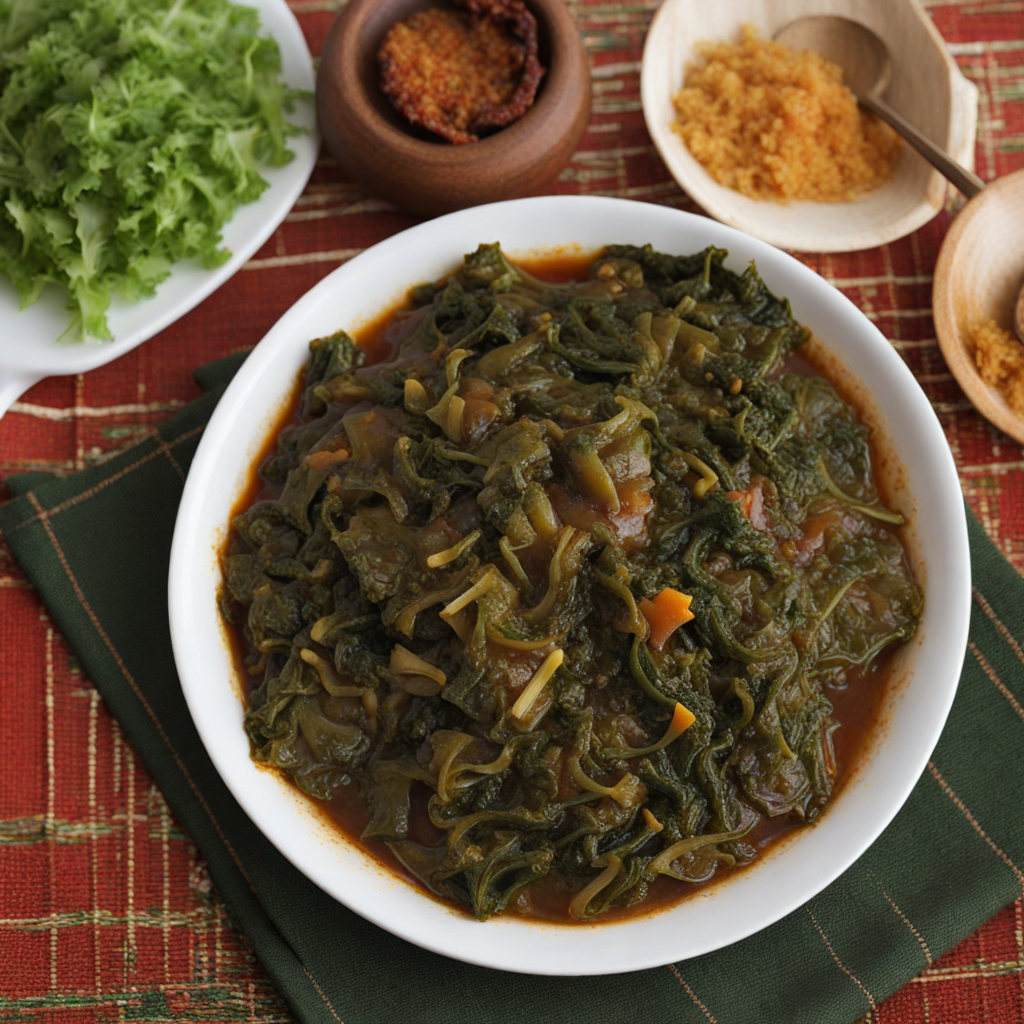Gomen
Gomen is a traditional Ethiopian dish that celebrates the rich flavors and textures of collard greens, which are the star ingredient. The greens are typically simmered until tender and then sautéed with a blend of spices, most notably garlic and ginger, which infuse the dish with aromatic depth. The slow cooking process allows the collards to absorb the savory flavors, creating a dish that is both hearty and satisfying. Gomen often features an earthy undertone, complemented by a slight bitterness that is characteristic of collard greens, making it a unique addition to any meal. In Ethiopian cuisine, Gomen is often enjoyed as part of a larger spread called a "beyaynetu," which consists of various stews and vegetables served on top of injera, a spongy flatbread made from teff flour. The combination of Gomen with injera is a delightful experience, as the injera serves as both a plate and a utensil, allowing diners to scoop up the greens and other dishes. When paired with spicy lentils or stewed meats, Gomen offers a refreshing contrast, balancing the heat with its mild yet flavorful profile. Beyond its taste, Gomen is also celebrated for its nutritional benefits. Collard greens are rich in vitamins A, C, and K, along with essential minerals like calcium and iron, making Gomen a wholesome choice for those looking to explore healthier eating options. The dish is often enjoyed by people of all ages and can be made vegan, allowing it to cater to various dietary preferences. Whether savoring it at a local Ethiopian restaurant or preparing it at home, Gomen promises a delightful journey into the vibrant world of Ethiopian flavors.
How It Became This Dish
The History and Cultural Significance of ጎመን (Gomen) in Ethiopian Cuisine #### Introduction In the rich tapestry of Ethiopian cuisine, few dishes are as emblematic or as cherished as ጎመን (Gomen), a dish primarily made from collard greens that embodies the essence of Ethiopian culinary traditions. Gomen is not merely a dish; it is a cultural artifact that reflects Ethiopia's agricultural practices, social customs, and the very essence of communal dining. This exploration delves into the origins, cultural significance, and the evolution of Gomen through the ages. #### Origins of Gomen The roots of Gomen can be traced back to Ethiopia's diverse agricultural landscape, which has been shaped by its unique climate and topography. Ethiopia is often referred to as the "Horn of Africa," boasting a variety of microclimates that allow for the cultivation of numerous crops. Among these, collard greens (Brassica oleracea) have thrived, becoming a staple vegetable in Ethiopian households. Collard greens are believed to have been domesticated in the Mediterranean region before spreading to various parts of the world, including Africa. In Ethiopia, the indigenous population began cultivating these greens centuries ago, integrating them into their diet. The cultivation of collard greens aligns with the Ethiopian practice of consuming seasonal and locally sourced foods, which is still prevalent today. Gomen, prepared using traditional methods and spices, became a staple dish, particularly in the highland regions of the country. #### Cultural Significance Gomen is more than just a nutritious green vegetable dish; it represents the heart of Ethiopian cultural practices and social norms. It is often served as part of a larger meal, typically accompanied by injera (a sourdough flatbread) and various stews, known as wot or wotet. The integrity of Gomen lies in its preparation, which includes sautéing the greens with spices such as garlic, ginger, and the essential Ethiopian spice mix, berbere, along with a generous amount of niter kibbeh (a spiced clarified butter). This preparation not only enhances the flavor of the dish but also illustrates the intricate balance of spices that characterizes Ethiopian cuisine. In communal gatherings, Gomen plays a crucial role in fostering a sense of community. Traditionally, meals in Ethiopian culture are served on a large communal platter, with diners using their hands to share the food. Gomen, with its vibrant green color and aromatic spices, adds to the visual and sensory appeal of these communal meals. The act of sharing Gomen, along with injera and other dishes, is a reflection of the values of generosity and hospitality that are deeply ingrained in Ethiopian culture. Moreover, Gomen is often associated with special occasions, including religious observances and family celebrations. During fasting periods in the Ethiopian Orthodox Christian calendar, when meat is typically avoided, Gomen becomes a vital source of nutrition, often served with lentils or chickpeas to create a complete meal. Its versatility allows it to be prepared in various ways, adapting to the dietary needs and preferences of the community. #### Development Over Time As Ethiopia underwent various historical changes, so too did the preparation and significance of Gomen. The country has experienced political upheaval, economic challenges, and cultural exchanges with neighboring nations, all of which have influenced its culinary practices. During the imperial era, particularly under the reign of Haile Selassie, Ethiopian cuisine began to gain international recognition. This period saw the introduction of more diverse ingredients and cooking techniques, further enriching the flavors of traditional dishes, including Gomen. The influence of foreign cuisines, particularly from Arab and Italian cultures, introduced new flavors and cooking methods that were gradually assimilated into Ethiopian cooking. The Ethiopian diaspora has also played a significant role in the evolution of Gomen outside of Ethiopia. As Ethiopians migrated to various parts of the world, they brought with them their culinary traditions, including Gomen. In countries such as the United States, Gomen has found a new audience, often served in Ethiopian restaurants that celebrate the country's culinary heritage. The dish has adapted to suit local tastes, with variations emerging based on available ingredients and regional preferences. In contemporary Ethiopia, Gomen remains a staple in both urban and rural settings. It is not only a common dish found in homes but also features prominently in restaurants, highlighting its enduring popularity. The rise of health consciousness has also contributed to its status, as Gomen is recognized for its nutritional benefits, being rich in vitamins, minerals, and dietary fiber. #### Conclusion In conclusion, Gomen stands as a testament to the rich agricultural heritage and culinary traditions of Ethiopia. Its origins rooted in the country's diverse landscapes, combined with its cultural significance in communal dining and celebrations, make it a beloved dish that transcends generations. The evolution of Gomen reflects the resilience and adaptability of Ethiopian cuisine, as it has embraced changes while maintaining its core identity. As a dish that embodies the spirit of sharing, Gomen continues to play a pivotal role in the social fabric of Ethiopian life. It remains a symbol of hospitality, unity, and tradition, inviting all who partake in its flavors to experience the warmth and richness of Ethiopian culture. Whether enjoyed in a bustling restaurant or at a family gathering, Gomen serves as a delicious reminder of the deep-rooted customs and the enduring legacy of Ethiopian cuisine.
You may like
Discover local flavors from Ethiopia







